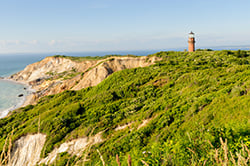
How well do YOU know Martha’s Vineyard?
We bet you didn’t know this! Martha’s Vineyard is a beautiful island south of Cape Cod in Massachusetts. The Vineyard or The Rock, as it’s been nicknamed, is an almost magical place, rich with natural beauty and colorful history. How well do you know how Martha’s Vineyard came to be?
Did you know. . .
The first people to live on Martha’s Vineyard probably weren’t on an island.
The geography of cliffs and streams tells the story of a melting Ice Age. Most likely, the first settlers here arrived after the Ice Age, but before the ocean rose enough to separate Martha’s Vineyard and Nantucket from the mainland.
Did you know. . .
Chappaquiddick Island is a smaller island, usually connected to the larger one (Martha’s Vineyard). But it’s been known to be separated by storms and hurricanes like the one in 2007. In 2015, it’s connected again.
The first people to live on Martha’s Vineyard were Native Americans—the Wampanoag—meaning “People of the First Light.” How long have they lived here? Native-American camps have been found on the island that were carbon-dated to 2270 B.C.
How did Martha’s Vineyard get its name?
There is more than one theory. In 1602, an explorer named Bartholomew Gosnold named the island for his eldest daughter, or mother-in-law, both of whom were named Martha, and for the wild grapes that grew here. For a while, it was called Martin’s Vineyard, after Gosnold’s ship’s captain. In the early 20th century, it was officially named Martha’s Vineyard.
Before Gosnold arrived, there’s been a lot of speculation about who arrived first after the Native Americans. It’s believed that Norsemen were here around 1000 A.D., and other explorers came in the 1500s, giving the island different names. To the Wampanoag, it was called Noepe, meaning “land amid the waters.” To this day, the Wampanoag live on aboriginal lands at the southwestern part of the island, on a 3400-acre peninsula called Aquinnah.
White settlers arrive on Martha’s Vineyard. . .
Thomas Mayhew, son of an English settler began the first white settlement in 1642 at Edgartown, which used to be called Great Harbour. Mayhew became friends with a Wampanoag neighbor, which led to some of the tribe converting to Christianity.
Did you know. . .
The first American Bible was printed in the Wampanoag language!
A kinder history on Martha’s Vineyard
Unlike the terror going on in the rest of the New World, with Native American massacres and removal by force, the early settlers of Martha’s Vineyard treated the Wampanoag with respect. A minister instituted a policy where no lands would be taken from the Wampanoag without their consent and fair payment. This was unheard of at this time in the rest of the country.
Martha’s Vineyard was also a safe haven for African people who were escaping slavery. This Colonial time period was one of supportiveness and cooperation, with Wampanoag people teaching the settlers how to capture whales and boil the oil. Farms were going strong. In the early 1700s, butter and cheese were major exports. All seemed peaceful. . .until the American Revolution.
Visit our blog for Part 2 of the exciting history of Martha’s Vineyard. And be sure to visit the museums and historical sites on the island to learn more when you go.
Before you go, call on us at A-A Island Auto Rental. We’ll get you where you want to go on Martha’s Vineyard. Contact us today!
